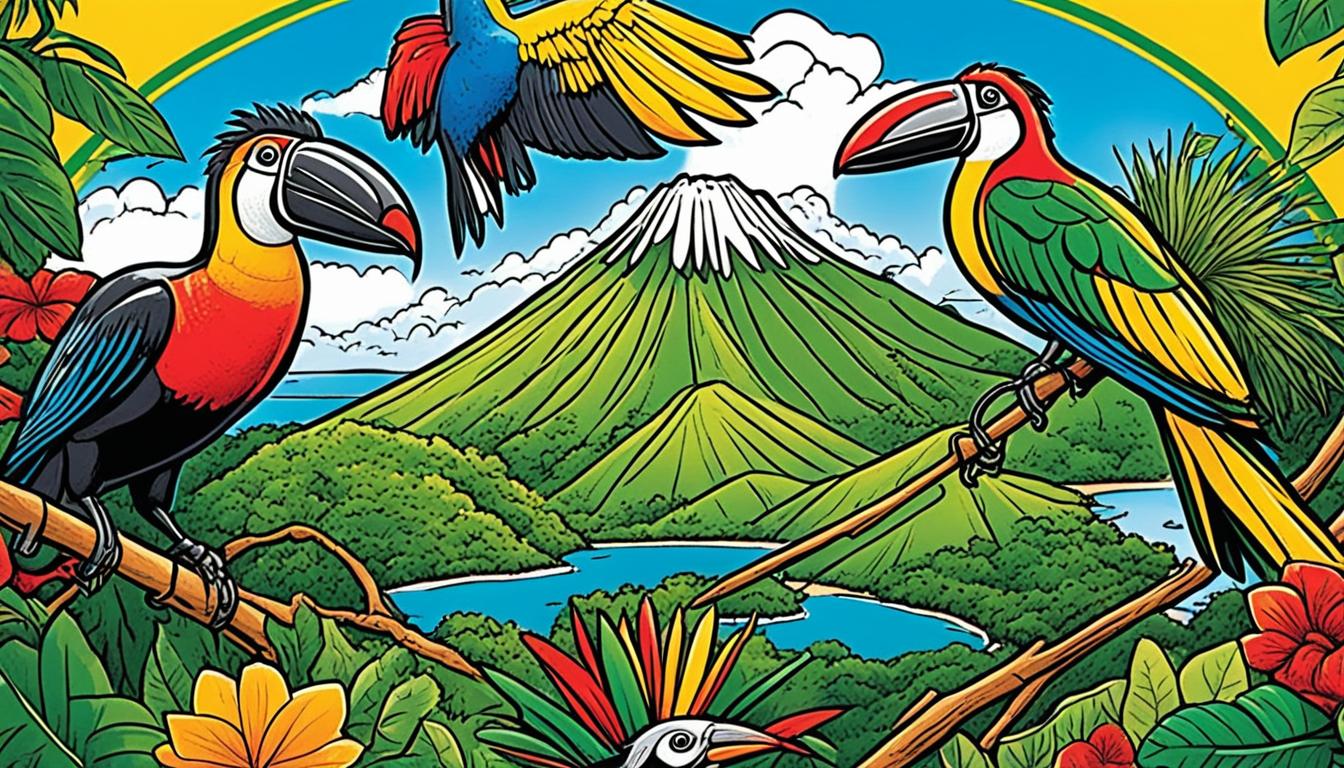With over 4,600 speakers in Brazil and 7,020 in Colombia, the Tucano Language is spoken by the indigenous Tucano people in the Amazonas region. This indigenous language, also known as Tukano or Tucana, plays a significant role in preserving the cultural heritage and traditions of the Tucano community. It is part of the larger Tucanoan language family, specifically the Eastern North Tucano branch.
As Brazil strives to protect its indigenous languages and promote linguistic diversity, understanding the unique features of the Tucano Language is vital. From its official language status in São Gabriel da Cachoeira to its use as a lingua franca in the Río Vaupés area, Tucano plays a crucial role in fostering communication and cultural exchange among indigenous groups.
In this article, we will explore the Tucano Language’s phonology, its status as a lingua franca, and the diverse dialects spoken within the Tucano community. Join us as we delve into the rich linguistic tapestry of Brazil’s indigenous languages and learn more about the incredible Tucano Language.
Language Status and Codes
The Tucano Language holds official language status in São Gabriel da Cachoeira, a municipality located in the Amazonas state of Brazil. This recognition signifies the importance and cultural significance of Tucano as a language within the region. Additionally, Tucano is classified under the Tucanoan language family, further highlighting its linguistic heritage and connections.
Tucano is identified with two ISO 639-3 codes: tuo for Tucano and arj for Arapaso, a dialect of Tucano. These language codes provide a standardized way to represent and reference Tucano and its variations. They facilitate communication, documentation, and research about the language, promoting linguistic understanding and preservation.
Tucano’s official language status and language codes demonstrate the commitment to recognizing, preserving, and celebrating the linguistic diversity present in Brazil.
Example Quote:
Tucano, as an official language and represented by distinct language codes, exemplifies Brazil’s dedication to acknowledging the linguistic richness that exists within the country. The recognition given to Tucano serves as a valuable reminder of the importance of preserving and nurturing indigenous languages worldwide.
Phonology of Tucano Language
The Tucano Language is characterized by its unique phonological features, encompassing a diverse range of consonant and vowel sounds. These distinctive sounds contribute to the rich and expressive nature of the language.
Consonants: Tucano boasts a consonant inventory that includes bilabial, alveolar, palatal, velar, and glottal sounds. These encompass plosives, nasals, fricatives, trills, and approximants, resulting in a wide range of phonetic possibilities.
Vowels: Tucano exhibits a rich vowel system, comprising of front, central, and back vowels. These vowels are further classified based on their positions, which include high, mid, and low. The vowel inventory adds complexity and nuance to the pronunciation of words in Tucano.
In addition to consonants and vowels, Tucano also includes nasal sounds and tonal distinctions. This creates a melodic quality in the language and enhances the overall linguistic experience.
“The phonological features of Tucano contribute to the unique sound system of the language, making it a fascinating subject of study for linguists and language enthusiasts alike.”
Tucano Language Speakers and Dialects
Tucano language, a vital component of Brazil’s linguistic diversity, is spoken by approximately 4,600 individuals in Brazil and 7,020 in Colombia. The Tucano people, residing predominantly in the northwest region of Brazil’s Amazonas state, specifically in São Gabriel da Cachoeira and surrounding areas, utilize Tucano as their primary language. Moreover, neighboring tribes also embrace Tucano as a secondary language, further enhancing its influence and reach.
The Tucano language showcases remarkable dialectal variations within Brazil. These dialects include Yohoraa, Wasona, Pisamira, Papiwa, Papihua, and Pisa-tapuyo. Each dialect represents a unique linguistic expression rooted in the cultural and geographic diversity of the Tucano people, enriching the overall tapestry of the Tucano Language.
Let’s explore the distribution of Tucano language speakers in Brazil and Colombia:
| Country | Number of Speakers |
|---|---|
| Brazil | 4,600 |
| Colombia | 7,020 |
(Please note that the numbers are approximate and subject to change as languages evolve and populations fluctuate.)
The existence of multiple dialects demonstrates the rich and diverse nature of the Tucano language, making it an invaluable cultural asset. However, it is essential to acknowledge that Tucano, like many indigenous languages, is classified as endangered. The preservation and revitalization of Tucano, along with other endangered languages, is crucial for maintaining linguistic diversity and safeguarding the cultural heritage of these communities.

Tucano Language as a Lingua Franca
Tucano language plays a pivotal role as a lingua franca in the Río Vaupés area, fostering communication and cultural exchange among approximately 20 different linguistic groups. This indigenous language, with its roots in the Tucanoan language family, transcends specific conditions and serves as a common means of understanding for diverse indigenous communities.
In the vast and linguistically diverse region of Río Vaupés, Tucano acts as a bridge, bringing together various indigenous populations through its widespread usage. Despite the linguistic differences among these groups, the Tucano Language becomes a unifying force, enabling cross-linguistic understanding and cooperation.
The lingua franca status of Tucano in the Río Vaupés area signifies its significance beyond traditional boundaries. It facilitates not only day-to-day communication but also the exchange of cultural practices, stories, and knowledge. This linguistic phenomenon strengthens the bonds between different linguistic groups and ensures cultural preservation within these communities.
By serving as a lingua franca, Tucano Language aids in the preservation of indigenous cultures and languages in the region. It allows for intercultural dialogue, enhances cooperation, and fosters a sense of unity among diverse linguistic communities. Tucano Language serves as an example of how language can transcend borders and play a vital role in promoting harmony, understanding, and inclusivity.
Conclusion
The Tucano Language, a vital component of Brazil’s indigenous cultural heritage, reflects the linguistic diversity and traditions of the Tucano people. As an official language in São Gabriel da Cachoeira and a recognized lingua franca, Tucano plays a pivotal role in preserving the indigenous identity and enabling communication among various indigenous groups.
By embracing the Tucano Language, individuals can gain a deeper understanding of Brazil’s rich cultural heritage and contribute to language preservation efforts. The unique phonological features of Tucano, including its consonants, vowels, and tonal distinctions, demonstrate the linguistic complexity and beauty of this indigenous language.
As we appreciate and support the Tucano Language, we celebrate Brazil’s indigenous languages and contribute to the preservation of linguistic diversity. The preservation of the Tucano Language is not only a testament to the Tucano people’s rich history but also a recognition of the importance of indigenous languages in maintaining cultural identity and fostering intercultural understanding in Brazil.
FAQ
What is the Tucano Language?
The Tucano Language, also known as Tukano or Tucana, is an indigenous language spoken by the Tucano people in the Amazonas region of Brazil and Colombia. It is part of the Tucanoan language family.
How many speakers does Tucano have?
There are approximately 4,600 speakers of Tucano in Brazil and 7,020 speakers in Colombia.
Is Tucano an official language in Brazil?
Yes, Tucano is recognized as an official language in São Gabriel da Cachoeira, Brazil.
What are the phonological features of Tucano?
Tucano has a variety of consonants and vowels, including plosives, nasals, fricatives, trills, and approximants. It also has nasal sounds and tonal distinctions.
Where do the Tucano people live?
The Tucano people primarily inhabit the northwest region of the Amazonas state in Brazil, specifically in São Gabriel da Cachoeira and surrounding areas.
How many dialects of Tucano are there?
There are several dialectal variations of Tucano in Brazil, including Yohoraa, Wasona, Pisamira, Papiwa, Papihua, and Pisa-tapuyo.
Does Tucano serve as a common language among different indigenous groups?
Yes, Tucano serves as a lingua franca in the Río Vaupés area, facilitating communication among around 20 different linguistic groups.
What is the importance of the Tucano Language?
The Tucano Language is an integral part of Brazil’s indigenous cultural heritage, representing linguistic diversity and traditions. It plays a crucial role in preserving the indigenous identity and promoting communication among indigenous groups.
